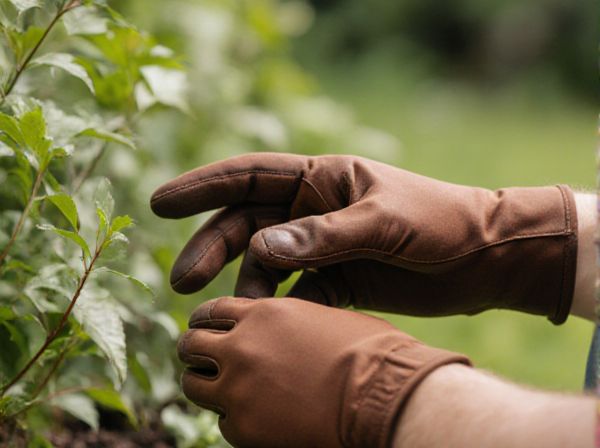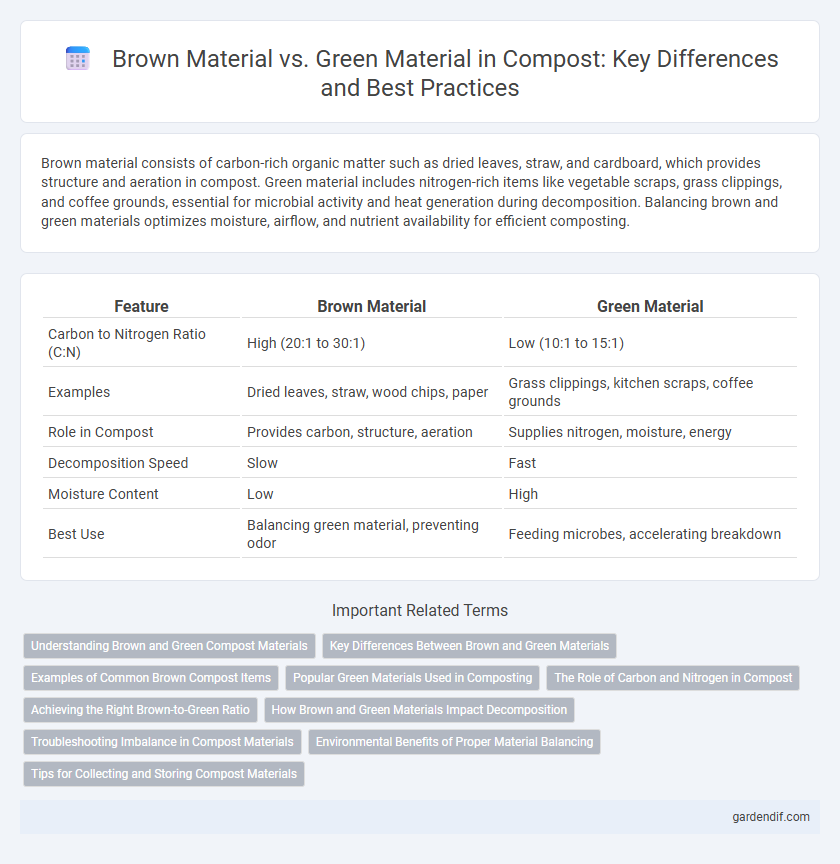
Brown Material vs Green Material Illustration
Brown material consists of carbon-rich organic matter such as dried leaves, straw, and cardboard, which provides structure and aeration in compost. Green material includes nitrogen-rich items like vegetable scraps, grass clippings, and coffee grounds, essential for microbial activity and heat generation during decomposition. Balancing brown and green materials optimizes moisture, airflow, and nutrient availability for efficient composting.
Table of Comparison
| Feature | Brown Material | Green Material |
|---|---|---|
| Carbon to Nitrogen Ratio (C:N) | High (20:1 to 30:1) | Low (10:1 to 15:1) |
| Examples | Dried leaves, straw, wood chips, paper | Grass clippings, kitchen scraps, coffee grounds |
| Role in Compost | Provides carbon, structure, aeration | Supplies nitrogen, moisture, energy |
| Decomposition Speed | Slow | Fast |
| Moisture Content | Low | High |
| Best Use | Balancing green material, preventing odor | Feeding microbes, accelerating breakdown |
Understanding Brown and Green Compost Materials
Brown materials in compost, such as dried leaves, straw, and wood chips, provide carbon essential for microbial energy and structure. Green materials like grass clippings, kitchen scraps, and coffee grounds supply nitrogen crucial for microbial growth and protein synthesis. Balancing these carbon-rich browns with nitrogen-rich greens accelerates decomposition and produces nutrient-rich compost.
Key Differences Between Brown and Green Materials
Brown materials in composting, such as dried leaves, straw, and cardboard, are rich in carbon and provide structure to the compost pile, aiding in aeration and moisture retention. Green materials, including kitchen scraps, fresh grass clippings, and coffee grounds, are high in nitrogen, which fuels microbial activity and accelerates decomposition. Balancing the carbon-to-nitrogen ratio between brown and green materials is crucial for efficient composting, preventing odors and ensuring faster organic matter breakdown.
Examples of Common Brown Compost Items
Common brown compost materials include dried leaves, straw, wood chips, sawdust, and cardboard, all rich in carbon. These items provide structure and aeration to the compost pile, balancing moisture and promoting microbial activity. Browns contrast with green materials, which are high in nitrogen, such as grass clippings and kitchen scraps.
Popular Green Materials Used in Composting
Popular green materials used in composting include grass clippings, fruit and vegetable scraps, coffee grounds, and fresh garden trimmings. These materials are rich in nitrogen, which accelerates microbial activity essential for effective decomposition. Incorporating a balanced mix of green and brown materials ensures optimal moisture and nutrient content for successful composting.
The Role of Carbon and Nitrogen in Compost
Brown material, rich in carbon, provides the energy source necessary for microbial activity during composting, while green material supplies nitrogen, essential for protein synthesis and microbial growth. Maintaining an optimal carbon-to-nitrogen (C:N) ratio, typically around 30:1, accelerates decomposition and minimizes odors. Imbalanced C:N ratios can slow composting and create ammonia emissions, highlighting the importance of properly blending brown and green inputs.
Achieving the Right Brown-to-Green Ratio
Achieving the right brown-to-green ratio in composting is crucial for effective decomposition and odor control, with a recommended proportion of about 3:1 carbon-rich brown materials to nitrogen-rich green materials. Brown materials include dry leaves, straw, and cardboard, which provide necessary carbon, while green materials such as grass clippings, food scraps, and coffee grounds supply nitrogen. Balancing these components optimizes microbial activity, accelerates composting, and produces nutrient-rich soil amendments.
How Brown and Green Materials Impact Decomposition
Brown materials, rich in carbon, provide the necessary structure and energy for microbial activity during decomposition, slowing down the process and preventing odor issues. Green materials, high in nitrogen, accelerate decomposition by supplying essential nutrients that boost microbial growth and heat generation. Balancing the carbon-to-nitrogen ratio between brown and green materials is crucial for efficient composting and optimal breakdown of organic matter.
Troubleshooting Imbalance in Compost Materials
Excessive brown materials such as dry leaves or cardboard can slow down decomposition by creating a carbon-rich environment lacking sufficient nitrogen from green materials like grass clippings or food scraps. A balanced carbon-to-nitrogen (C:N) ratio around 30:1 is critical to maintaining active microbial activity and avoiding issues like slow composting or unpleasant odors. Adjust compost piles by adding more green material to increase nitrogen levels or introduce additional brown material if the pile becomes too wet and compacted, ensuring optimal aeration and moisture content.
Environmental Benefits of Proper Material Balancing
Balancing brown material, such as dry leaves and cardboard, with green material like kitchen scraps and grass clippings enhances compost aeration and accelerates microbial activity, resulting in faster decomposition and nutrient-rich soil. Proper ratio management reduces methane emissions by preventing anaerobic conditions, supporting climate change mitigation efforts. Optimized composting minimizes landfill waste and promotes a sustainable cycle of organic matter reuse, benefiting soil health and biodiversity.
Tips for Collecting and Storing Compost Materials
Collect brown materials such as dry leaves, cardboard, and straw, which provide essential carbon for compost balance, while green materials like kitchen scraps, grass clippings, and coffee grounds supply nitrogen. Store brown materials in a dry, ventilated area to prevent mold and maintain aeration; keep green materials in sealed containers or compost bins to reduce odors and pest attraction. Chop or shred larger brown materials to accelerate decomposition and layer green and brown materials evenly for optimal airflow and microbial activity.
Brown Material vs Green Material Infographic

 gardendif.com
gardendif.com